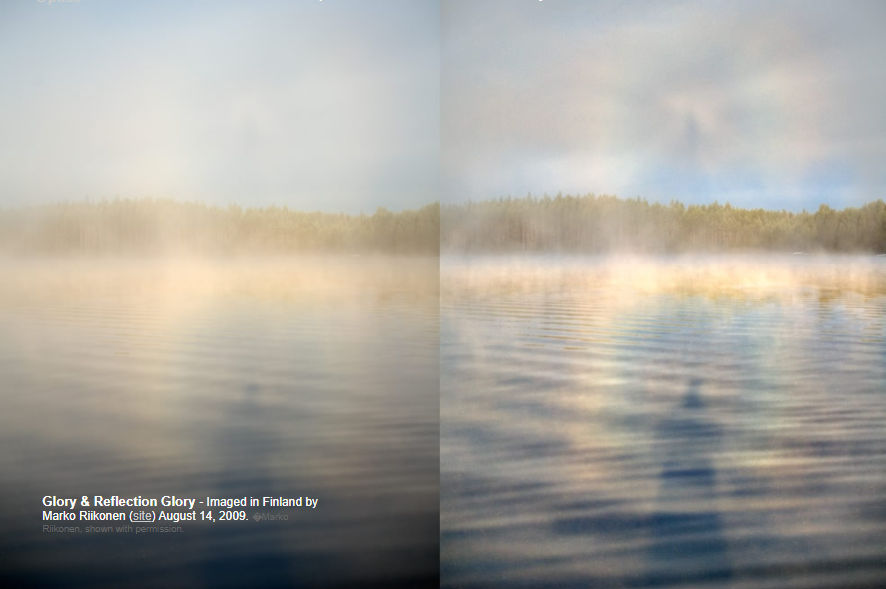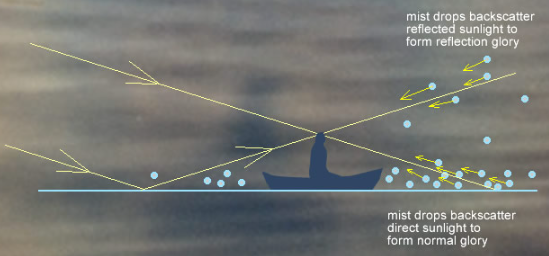Very rare reflection glory
Very Rare Reflection Glory: A Phenomenon Worth Exploring
Atmospheric optics can be a fascinating field, filled with mesmerizing and rare phenomena that captivate the imagination. One such phenomenon is the very rare reflection glory. While glories are not uncommon, the occurrence of a reflection glory is a sight that few have been fortunate enough to witness. In this article, we will delve deeper into the intricacies of the reflection glory, its formation, and the conditions necessary for its occurrence.
What is a Reflection Glory?
A glory is an optical phenomenon that appears as a series of concentric rings of colors surrounding the shadow of an observer's head. It is caused by the backscattering of sunlight by tiny water droplets or ice crystals suspended in the atmosphere. The reflection glory, as the name suggests, is a type of glory that forms when sunlight is reflected off a surface, such as a body of water, before being scattered by the atmospheric particles.
The Formation of a Reflection Glory
To understand how a reflection glory forms, let's imagine two suns. The first sun is located above the horizon and shines downwards, while the second sun is positioned the same distance below the horizon but shines upwards. When sunlight reaches the surface of a lake or any other reflective surface, it gets reflected and creates an upward-going set of rays.
These upward-going rays cast a second shadow onto any mist or fog present in the atmosphere. The mist droplets in the direction of the antisolar point (the point opposite to the sun) backscatter the reflected rays, resulting in the formation of the second glory - the reflection glory.
Rare Sightings and Conditions for a Reflection Glory
The rarity of reflection glories can be attributed to specific conditions required for their formation. One such condition is the presence of fog clouds with sharp edges and clear sky in between. These fog clouds act like cumulus clouds, providing a distinct boundary for the reflection to occur. Additionally, the presence of unisized droplets along the edge of the fog cloud further enhances the glory's appearance.
However, finding these optimal conditions is no easy task. Marko Riikonen, an atmospheric optics expert, captured a reflection glory in 1987 under such perfect circumstances. Since then, he has been hoping for a similar opportunity but has encountered only more or less uniform fog all over the lake. Despite this, Marko's achievement in capturing the reflection glory on camera is remarkable.
Glory versus Reflection Glory
It's important to distinguish between the two types of glories: the ordinary glory and the reflection glory. The ordinary glory is the lower one, formed by mist droplets backscattering the downward rays of the low sun. On the other hand, the reflection glory is the upper one, created by droplets in the direction of the antisolar point backscattering the reflected rays from the lake.
Reflection Rainbows: A Similar Phenomenon
Just as reflection glories form from reflected sunlight, reflection rainbows share a similar origin. When sunlight is reflected off a surface, such as water, and undergoes internal reflection within raindrops, a reflection rainbow can appear. These rainbows are often seen above bodies of water or near waterfalls, creating a stunning display of colors.
In conclusion, the very rare reflection glory is an optical phenomenon that occurs when sunlight is reflected off a surface before being scattered by atmospheric particles. While glories are not uncommon, witnessing a reflection glory is a rare and extraordinary experience. The formation of a reflection glory requires specific conditions, including fog clouds with sharp edges and clear sky in between. Marko Riikonen's achievement in capturing this phenomenon on camera serves as a testament to the beauty and wonder of atmospheric optics. So keep your eyes peeled and your hopes high, for you never know when you might witness the elusive reflection glory.

Glory & Reflection Glory - Imaged in Finland by Marko Riikonen (site) August 14, 2009. �Marko Riikonen, shown with permission.

Glories for connoisseurs. Atmospheric optics expert Marko caught the double glory, one above the horizon, from a boat on an early morning mist swathed lake.
"I must emphasize that although this was visible to the naked eye, the right-hand shot is heavily unsharp masked. I saw a much better one in 1987. Then there were special conditions: the lake fog was not uniform, instead there were fog clouds - like cumulus - with sharp edges and clear sky in between. So, first of all the sun was shining with full vigour from behind as I placed myself before the fog wall and second, the edge of the cloud is a good place to have unisized droplets which gives best glories. After 1987 there has been only more or less uniform fog all over the lake: no full sun shines, no unisized droplets. But I keep living in hope."
Although Marko would like better, these pictures are a major achievement and show a very rarely observed phenomenon.
The ‘ordinary’ glory is the lower one. Mist droplets produced it by backscattering the downward rays of the low sun. Marko was facing away from the sun and the shadow of his head (or rather, the camera shadow) is at the antisolar point and the glory’s centre.
Rays reflected from the lake behind Marko produced the upper glory, the 'reflection glory'. The upward going rays cast a second shadow onto the mist. Droplets in the direction of the antisolar point of the reflected sun – more properly called the anthelic point – backscattered the reflected rays to form the second glory.
Think of the two glories being made by two suns. The first sun above the horizon and shining downwards. The second the same distance below the horizon but shining upwards.
Reflection rainbows form the same way.
More of Marko's day in the next OPOD
Note: this article has been automatically converted from the old site and may not appear as intended. You can find the original article here.
Reference Atmospheric Optics
If you use any of the definitions, information, or data presented on Atmospheric Optics, please copy the link or reference below to properly credit us as the reference source. Thank you!
-
<a href="https://atoptics.co.uk/blog/very-rare-reflection-glory/">Very rare reflection glory</a>
-
"Very rare reflection glory". Atmospheric Optics. Accessed on April 20, 2024. https://atoptics.co.uk/blog/very-rare-reflection-glory/.
-
"Very rare reflection glory". Atmospheric Optics, https://atoptics.co.uk/blog/very-rare-reflection-glory/. Accessed 20 April, 2024
-
Very rare reflection glory. Atmospheric Optics. Retrieved from https://atoptics.co.uk/blog/very-rare-reflection-glory/.